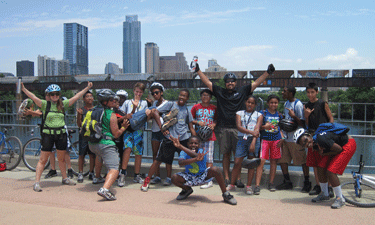 Municipality: Austin, Texas
Municipality: Austin, Texas
Population: 885,400
Year Agency Founded: 1928
Annual Operating Budget: $72,591,252
Director: Sara L. Hensley, CPRP
Full-time Employees: 665
Seasonal Employees: 1,272
Volunteers: 13,221
Essential Information
More than 29,000 acres of parkland, 271 parks, 211 miles of trails, 94 sports fields, 77 basketball courts, 50 aquatics facilities, 20 recreation centers, 12 off-leash dog areas, 11 museums/arts and cultural centers, 10 stages/amphitheaters, six golf courses and five cemeteries.
Connecting Children to Nature
“We set our goals high,” says Ryan Eaker, program coordinator at Austin Parks and Recreation’s Lorraine “Grandma” Camacho Activity Center. “Austin is changing and growing, and our type of programming is in high demand. We want to reach as many different populations as we can to provide that outdoor programming for everyone.”
Camacho employs a unique nature outreach program designed to work with its sister recreation centers, rather than angling for an audience all its own. Eaker points out that Camacho is an “activity center,” not a traditional recreation center, and thus is without gym space or traditional sports programming. It’s located on a hike and bike trail surrounding Lady Bird Lake in east-central Austin with access to a lagoon that provides opportunities for nature-based education. “Especially in the summertime, we use the trail as our highway,” Eaker says. “Every day, all day, we’re outside on bikes and boats.”
Because Camacho lacks the sports programming that typically draws in youth and families, Eaker said its after-school activities were suffering. “We were competing with recreation centers within our own organization,” he says. “We decided a couple of years ago to focus on something we’ve been doing for a several years anyway, and expanded the nature-based outreach for after-school enhancement programs. We offer those programs to 20 other rec centers in Austin on a daily basis.” This means children in more urban areas of the city can access the same nature- and arts-based programming offered to regular Camacho visitors, without having to travel. “We put on different programs including geocaching, Waterbugs (a hands-on water ecology program), natural tie-dyeing where kids make dyes out of natural plants…We also do archery and nature photography, and we invite closer rec centers to participate in mountain biking or kayaking on the lake with us.”
Eaker also points out Austin Parks and Recreation has completely overhauled its public-facing efforts and is now fully immersed in the social media universe with a YouTube channel, Facebook page and Twitter handle. “That combination of online presence in different platforms means people are finally finding us, and now our biggest challenge is to meet that demand,” Eaker says.
Leveraging Environmental Assets
Just across Interstate 35 lies Pease Park, another gem under the Austin Parks and Recreation umbrella. Here, park leaders have undertaken a major effort to restore the Shoal Creek watershed, plant hundreds of new trees and improve playground and trail sites. Last October, a master plan focused on Pease Park was adopted, outlining an initiative to increase its tree canopy, species diversity and overall health. Applying the plan in concert with the community-funded Pease Park Conservancy, Kim McKnight, MHSP and project coordinator and cultural resource specialist with Austin Parks and Recreation’s Planning and Development Division, says major strides have been made. “Through this $6 million stream and riparian rehabilitation project at Shoal Creek, we have seen incredible large-scale stream bed and creek restoration,” she says.
“The Pease Park master plan is, from a planning perspective, one of the best examples of our conservation efforts,” McKnight continues. “We know we’re the fastest-growing city of our size in the country. We will have to absorb that population increase and prepare our parks so they can absorb this vast population explosion.
“I’m really proud of the work we’ve done as an agency. Our partnerships help us foster greater conservation and nature programming. There are a lot of people in central Texas who are working hard to connect children and nature, and our department plays a large role in implementing those initiatives.”
Samantha Bartram is the Associate Editor of Parks & Recreation magazine.

